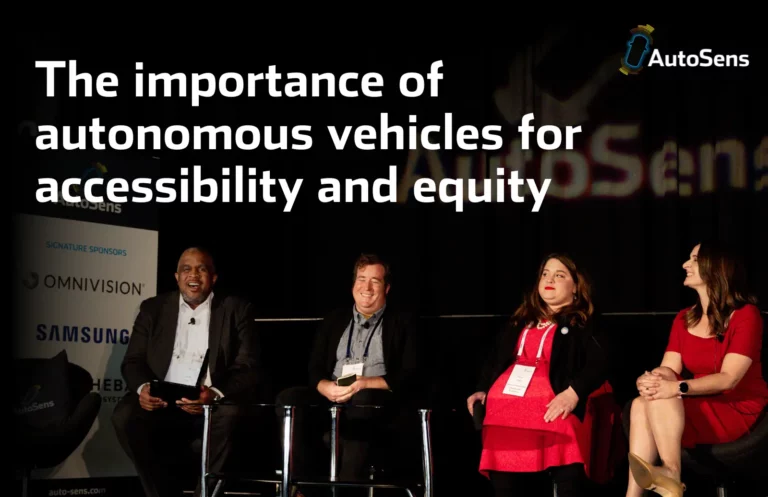Gender inequality is a huge problem in the automotive industry. Working for an events company, and having worked in marketing, events and media for most of my career, I have mostly worked in very balanced environments – and in fact on several, occasions, as a man, I’ve been in the minority. Now I’m working in the Automotive sector, that’s changed. Most of the AutoSens team are female, but most of our customers are male.
An old friend of mine, with 3 tours in Afghanistan (running a company of engineers servicing everything from Chinooks to Tanks) under their belt, is now second in command of the local Army Reserve unit. They are also the production line manager of a large car manufacturer. She also likes kittens.
Gender shouldn’t mean anything detrimental, so go back a few seconds and consider the thoughts that went through your head while reading the preceding paragraph.
Apart from that example, and indeed a very small handful of other female engineers I know of at companies such as Valeo and Jaguar Land Rover, the imbalance is still very noticeable.
Even in the ‘most balanced’ European labour markets, and that itself is a terribly inaccurate label, Latvia and Hungary lead the way (>30%), followed by Sweden, France, Ireland (all >20%) before reaching the doldrums of Denmark, Italy and Germany (all ~15%) and embarrassingly, the UK at a slice above 5%.
Just looking at some indicative stats on our website, audiences are changing, slowly.
Among visitors to our website in the lower age brackets, the imbalance is shrinking (18-24 = 33% female, 25-34 = 28% female) – but that suggests there’s still a lot of work to do.
When we compare the overall website figures to event attendees, we see a markedly different picture. A disparity between the gender of website visitors (around 20% female) and visitors to our events (less than 10% female).
Don’t leave it to women to fly the flag!
We are one of many organisations and employers that feels this is detrimental to the marketplace, not least because of the many talented scientists, technologists and engineers employed in the market place.
Prior to writing this article, we reached out to a number of women in senior engineering working in the automotive technology field, asking a number of questions about how to re-balance the gender split. Unfortunately, they were, perhaps in line with some of the research that’s referenced here, far too busy being hugely successful trailblazers.
That made me think – while female engineers are important mentors and role models for influencing career choices – it’s also presumptive and unnecessary to believe that industry cannot take on some responsibility, irrespective of the gender of people talking about it. I’m writing as a man, a father, and I would do anything to ensure my own daughters have successful and happy lives, with good careers – and never let gender stand in their way.
Not that I’m short of male role models, but I am fortunate to have a broad spread of strong female role models too. Both my mother and grandmother have spent time as full-time parents, but one was a wartime spy, and the other helps to run Stonehenge. I don’t doubt that attitude influenced the positive do-anything attitude I have imbued in my children.
“Women in Engineering” Tickets!
Not wanting to get too off-topic, what can we do about it as a company? Writing about the problem is not enough. So we have added a limited number of “Women in Engineering” tickets for our AutoSens Conferences. We want more women to be involved in AutoSens, shaping the future of vehicle perception technology
[embedit snippet=”wie-book-button”]
Whether the logic or solution is sound is not for us to judge, however, if age and seniority influences whether it’s cost effective for someone to attend AutoSens (most often senior engineers, where the gender bias is at its worst) we hope that creating a low-cost ticket that is gender focussed will enable women in the industry to take advantage of the event.
We know that our events are useful learning experiences, with networking, conference sessions, exhibition displays and time among other experienced professionals.
It might just be the opportunity some bright sparks need to step their career up a notch, and show the industry what women really have to offer.
[embedit snippet=”wie-book-button”]
What they thought at AutoSens Brussels?

We caught up with Margaret Belska from NVIDIA at AutoSens Detroit this May.
She had this to say about women in engineering…
“I’m pleasantly surprised at how many women there are attending [AutoSens], also very happy to see several women speakers – I’m sure that’s even harder than just getting attendees. Its fantastic to have that representation. We are here, we work in this field, there’s not a lot of us but the more of us [that can be seen here], is going to inspire more women to come into the field and contribute. … Women are a really big part of this industry, and being able to contribute to the development of these technologies is really important. You need that different perspective.”
Country study – How the UK aims to rebalance the market
The gap in the UK is far greater than other European countries, so the UK Government aims to create opportunities for all and close the gender gap, not just by highlighting any pay differences (for larger employers, now obliged by law).
Its plans including a ‘Women in Innovation’ programme, aim to make significant impacts, but realistically won’t begin to level off the imbalance for 5-10 years. Plans include dedicated funding including conversion programmes, female focused innovation incubators, additional InnovateUK sponsored competitions focused on themes, digital coding camps and use the power of public sector procurement to secure private sector action on gender based skills.
The goal is to secure a balanced gender workforce. The huge gender imbalance that is recognised in the engineering, science and technology world (per research undertaken by the Royal Academy of Engineering in 2016) should be considered as an exciting opportunity for the automotive technology market.
Baroness Martha Lane Fox – Tech entrepreneur, board member of Twitter and founder of Lastminute.com – continues to promote the uptake of some 800,000 unemployed women or mothers wanting to return to the workforce. As a philanthropist, she has more recently founded Doteveryone, a research and think tank aimed at achieving equality online. One of their workstreams, 5050tech, is focussed specifically on gender, with the aspiration that half of the UK’s tech workforce are women in ten years’ time.
Today, women occupy only 17 percent of tech specialist jobs. Fewer than 1 in 10 of these women are in leadership positions, and there is a significant gap in gender pay across the industry. But there’s a twist. Doteveryone’s research shows that high-tech companies led by women are more capital-efficient than the norm.
In its report on Britain’s Digital Future, the House of Lords Select Committee identified that increasing the number of women working in information technology (IT) alone could generate an extra £2.6 billion each year. Their ‘Make or Break’ report, also published in 2015, cited the lack of women in technology-driven industries being much wider than just the digital economy, with women representing only 6% of the engineering workforce and only 15.5% of the science, technology, engineering and mathematics (STEM) workforce.
The Institute for Public Policy Research, suggested the problem could be reduced to four key challenges:
- Too few girls (14-19 yrs) acquire the prerequisite qualifications in STEM subjects
- Addressing the unhelpful perception of STEM and engineering careers, among both girls and their families, as ‘masculine’ or ‘brainy’
- Poor understanding of engineering careers, and the engineering pathway
- The STEM ecosystem is fragmented, which increases likelihood of duplication.
The IPPR went on to suggest a holistic approach to shaping girls’ ideas of what the future holds for them, driven by intervention at a much younger age. Using inclusion training for teachers, access to diverse role models and mentors for pupils from primary school onwards. Better careers advice would help to de-mystify career options in science – again, this should start as early as possible, and be implemented in the primary school curriculum, and it should also involve working with local employers.
Because aspirations are in part shaped by family and other key influencers, it is also important to work with families to boost science capital, meaning more students and families know that pursuing science keeps doors open instead of shutting them down, and would meant that more young girls will consider engineering as a rewarding and fruitful career option.
LIMITED number available! Purchase your “Women in Engineering” Tickets for AutoSens today
[embedit snippet=”wie-book-button”]






